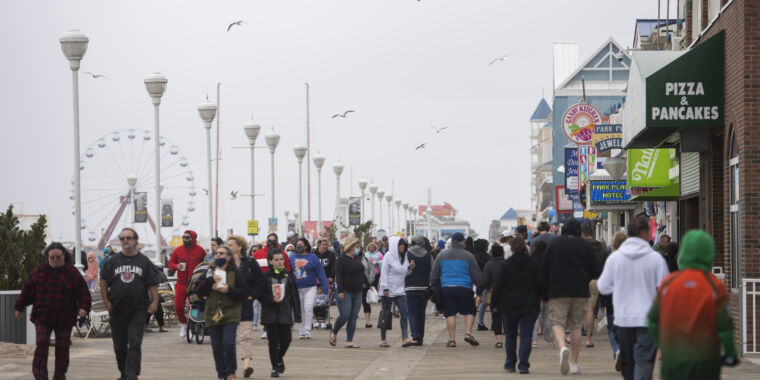
Much about how the new coronavirus spreads from one victim to the next remains a maddening mystery. But amid all the frantic efforts to understand transmission, there is one finding that appears consistent: that it is inconsistent.
Some people—most, even—don’t spread the virus to anyone in the course of their infection. Others infect dozens at a time.
It’s a phenomenon that looked, at first, like anomalous anecdotes—a large outbreak from a Washington choir practice, a South Korean megachurch, a wedding in Jordan—but it has become a fixed feature of the new coronavirus, SARS-CoV-2. And researchers have started to settle on numbers for it.
According to mounting data, as little as 10 percent to 20 percent of people infected with SARS-CoV-2 may be responsible for around 80 percent of transmission. On the flip side, a stunning 70 percent of infected people may not pass the virus to anyone, some data suggests.
Who will become a so-called superspreader, and why are there still unknowns? Is it something about their biology? Something about their infection? Something about their behavior? Some combination of those factors? Experts don’t know. But, they argue, we know enough to stop superspreading events—and potentially curb the pandemic.
Superspreading events tend to occur in specific settings—large social gatherings, bustling nightclubs, crammed workplaces. Instances where one apparently highly contagious person can spread it to many others in short order.
“It’s very difficult to identify an individual superspreader,” Barry Bloom, a distinguished professor of public health at Harvard, tells Ars. “It is not difficult to identify events that bring a very large number of people together in a small, enclosed space.”
Benjamin Cowling, a Hong Kong-based epidemiologist and biostatistics expert, agrees. Cowling and colleagues recently studied transmission in Hong Kong, finding superspreading events drove local transmission. In a recent op-ed, he and a colleague argue that public health policies aimed at stopping the pandemic should focus on stopping superspreading.
“The epidemic’s growth can be controlled with tactics far less disruptive, socially and economically, than the extended lockdowns or other extreme forms of social distancing that much of the world has experienced over the past few months,” the researchers wrote.
Cs of transmission
In an email to Ars, Cowling fleshed out this idea a bit, noting that “measures that specifically target superspreading are those that reduce or prevent large gatherings of people,” such as those to reduce the density of people in schools and workplaces.
Measures not specifically targeted to superspreading, he noted, “are those like asking everybody to stay at home as much as they can, despite many workplaces and social settings not being places that superspreading could occur.”
In the op-ed, Cowling noted that Japan—which has been relatively successful at managing the pandemic—has employed an anti-superspreading policy called the three Cs: Avoid (1) Closed spaces with poor ventilation, (2) Crowded places, and (3) Close-contact settings, such as close-range conversations. The risk for superspreading is highest in situations with all three Cs.
When Cowling and colleagues studied transmission in Hong Kong, which at the time had 1,038 cases, they found that those three Cs seemed to stand out. Superspreading played an outsized role in local transmission, with large clusters of cases linked to superspreading at bars, weddings, and temples. Other clusters linked to work parties, karaoke, and dinner parties.
Overall, 539 (52 percent) of all of Hong Kong’s cases were linked to one of 135 clusters, while 449 cases were sporadically imported and 50 were sporadic local cases not linked to any cluster. And of 349 local infections, 196 were linked to just six superspreading events. In one superspreading event, a single person seems to have infected 73 others in a cluster that eventually included 106 cases across bars where a network of musicians played.
Case collection
Overall, the researchers calculated that just 20 percent of Hong Kong’s cases were responsible for 80 percent of transmission. A further 10 percent of cases spread the infection to just one or two other people—mostly in household settings. And the remaining 70 percent of cases did not pass the infection to anyone.
Surprisingly, when the researchers looked at the people who were infected in superspreading events but didn’t go on to infect anyone else themselves, only 27 percent ended their infection in quarantine. The authors note that although Hong Kong didn’t have a strict lockdown or stay-at-home order, residents were following social distancing measures, including restrictions on gatherings.
Cowling and his colleagues’ analysis has been posted online but has not yet been peer-reviewed or published in a scientific journal. But, they note, their findings from Hong Kong aren’t unique. For instance, a study published in the Lancet in April, which looked at transmission of SARS-CoV-2 in Shenzhen, China, found that just around 9 percent of cases accounted for 80 percent of transmission. And a modeling study from researchers in London likewise found that just about 10 percent of cases may account for 80 percent of transmission.
The large role of superspreading in outbreaks not only has implications for social distancing measures in the public, it also informs public health officials about how to respond to cases, says William Hanage, an epidemiologist at Harvard’s school of public health. It shifts the focus from cases to transmission, he says.
For instance, when contact tracers identify a new case, they should make sure to not only look forward in time at who that infected person interacted with and may become sick, but they should also look backward to try to figure out how that new case themselves got sick.
“When you identify that transmission has occurred it means you should redouble your efforts to be testing and looking around there,” Hanage tells Ars. “Because identifying one transmission means it’s more likely that there will be others if you go look for them.”









